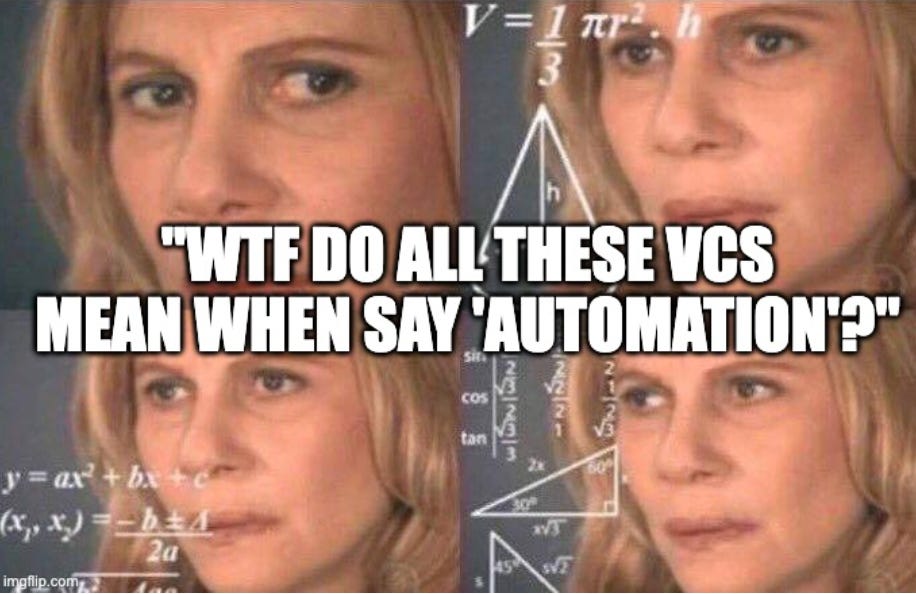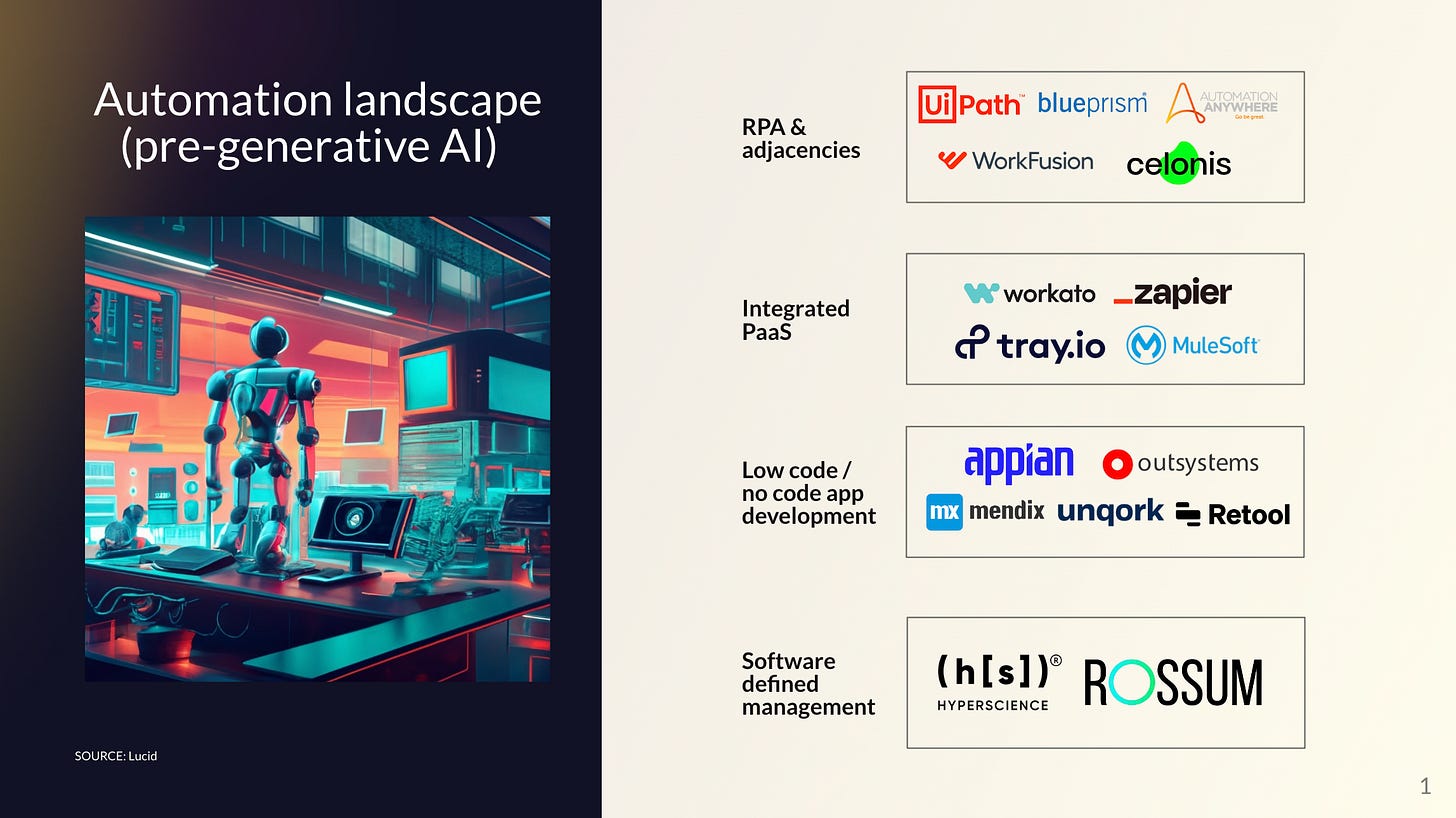Lucid Dreaming VII: Automation Next
Our GP Yash segments the enterprise automation space and shares predictions for the future of this category
Introduction
‘Automation’ is a buzzword that is frequently thrown around in tech circles.
While the term covers a wide spectrum of activities, at its essence, it simply refers to efforts to reduce human intervention in any process. This includes processes that involve hardware, sensors, machinery, and other control systems, in addition to software.
In this article, however, our aim is to demystify usage of the term in relation to software only. At Lucid, we believe in intelligent automation as one of our core thesis areas.
As a result, we’re publishing our understanding of the automation space, its key segments and how we believe each of these segments will change in light of the recent developments in generative AI.
Categorisation
It's undeniable that automation has experienced significant growth within enterprise software over the past 7 years. This growth has been primarily driven by the RPA market, with UI Path leading the charge since 2016. Initially, Gartner predicted that the category would grow at a rate of 30% CAGR. However, the enthusiasm surrounding this category has subsided somewhat in the past 12 months. UI Path's stock market valuation has declined, likely affected by a broader sell-off in public tech companies. Despite this, we believe that the recent emergence of generative AI is likely to impact this category significantly.
At Lucid we invest significant time in coming to conversations with potential founders with ‘prepared minds’. Back in 2021, I prepared our quick categorisation of the automation space. This categorisation was by no means polished or complete, but was designed to give ourselves a simple classificatory framework within which to contextualise the raft of companies coming to dominate this space. Since then, a new cadre of companies has emerged nipping away at the heels of incumbents.
Below we’ve included our brief explainer on each of these categories, outlined some of the new companies in each space, and included our predictions on how each sub-category might be impacted going forward.
RPA & Adjacencies
RPA, or Robotic Process Automation, involves automating various business processes by instructing a robot or 'bot' to perform a set of defined tasks. This typically includes simple and repetitive tasks such as data entry and transferring files from one location to another. The primary goal is to automate mundane and repetitive tasks in the workplace. Essentially, RPA can be thought of as an advanced version of 'screen-scraping'. In fact, the technology existed for several years prior to its commercialization by UIPath.
Some key rules to keep in mind when considering whether a process is suitable for automation are that:
The process is rule-based.
It has clear inputs and outputs.
It occurs at regular intervals.
It involves a significant volume of tasks
It's important to note that any changes in the system being targeted can potentially disrupt the functioning of the bot. As a response, new companies in this field are either focusing on solving this specific problem or providing automations that rely on clear API end-points or tasks confined within a web browser.
Example companies:
Induced AI: is re-architecting the foundations of RPA from the starting point of a new browser. Instead of running automations in a standard browser, the company has purpose-built a browser for running automations that has built in LLM reasoning capabilities. A user submits videos with the desired automation, or simply writes down the steps, and Induced will translate the automation into pseudo code that is then executed. This experiences contrasts with the rule-based workflows that are run in old RPA software, and aims to prevent the issue of bot breakage.
Automat AI: similar to Induced, Automat is also enabling users to submit automations using video recordings. Automat will then parse these videos and translate them into the pseudo code to execute the desired automation.
Magical: enables users to transfer data across websites, databases, sheets and forms. Here the software ‘remembers’ elements on webpages. Typing in a custom abbreviation (e.g. “@name,” “@email”) prompts Magical to insert snippets of text (e.g. “Alex,” “alex@example.com”) such as words, emojis, phrases, paragraphs, blocks of code or templates. Magical focuses only on Chrome at present.
Bardeen: appears to take a similar approach to automation as Magical, but has slightly broader scope in allowing users to run workflow automations across a broader range of SaaS tools. However, it is likely that Bardeen and Magical will likely converge towards running the same types of automations.
Luminai: Luminai records a video of a user jumping between different systems. This recorded keeps track of the clicks and keystrokes and with their software able to recognize if there is an API available or not, then replicates that exact same workflow in the background.
Prediction: Foundational AI models have evolved to become multi-modal, meaning they can now process both textual and visual data inputs. This advancement has paved the way for a realm in which alterations in the targeted system can be "recognized" by the bot, transcending the limitations of predefined rules or explicit scripting to execute automated tasks.
Both established companies and emerging players are poised to leverage this technology to enhance the sophistication and efficacy of their automation processes. With the ability to integrate both textual and visual cues, these AI models are expected to elevate the overall quality and versatility of automated operations. In other words, preventing ‘bot breakage.’
Integrated PaaS (iPaaS)
iPaaS, or Integration Platform as a Service, is software that involves the seamless transfer of data from one system to another. These systems or applications vary in complexity, spanning from intricate operations like migrating data from an on-premise SAP instance to a cloud-based system, to simpler tasks such as exporting all Salesforce customer data to a Google Sheet.
In this rapidly evolving field, many emerging companies are focusing on addressing multi-layered processes that involve human input or targeting specific industries that have been previously underpenetrated. They aim to streamline and simplify data integration.
Example companies:
Alloy Automation: has striking similarities to Zapier. Alloy chose initially to focus on e-commerce applications primarily for integrations. In fact, the company’s pitch at YC was ‘Zapier for e-commerce’. Launching during the pandemic timed nicely with the boom in e-commerce. The company has now progressed beyond this to white-label its product, allowing integration partners to serve up iPaaS capabilities to their customers. Moreover, the company has mirrored Merge.dev’s product by releasing a unified API for integrations. In others words, builders of SaaS applications will be able to easily provide integrations to common SaaS apps through the control plane of one standalone API.
Relay: covers off human-in-the-loop workflows. An example of this might be the transfer of data from one SaaS application to another having an intermediary step of human review. A human would be able to approve / review any critical automation before it runs. This company comes closest to one of my startup ideas, Yuzu (which somehow made it to the product of the day on Product Hunt. See here)
Tonkean: is a more enterprise grade version of Relay that spans more complex multi-step processes. The ICP in this instance is operations teams, who often work across multiple departments, and do not have dedicated standalone software to complete their work.
Next Matter: a lighter weight Tonkean for operations teams.
n8n.io: open source Zapier.
Prediction: We anticipate that the most significant impact of AI will lie in its ability to utilise natural language to help define integrations. When you require data from one platform (A) to synchronize with another (B), you won't need to understand the intricate workings behind the scenes; you'll simply need to articulate what you want to happen. For instance, you could instruct the system to "Update the customer lead score in Marketo within Salesforce." The AI will then take care of the process on your behalf. Additionally, AI will be responsible for constructing integration connectors for new systems.
Furthermore, even if your data is currently correctly mapped in your integrations today, this might not be the case tomorrow. When data isn't accurately mapped, it has the potential to compromise the quality of your insights or even disrupt the customer experiences you've meticulously crafted.
AI will continually monitor for errors in data mapping, comprehend the issue, and proactively mend any gaps. This approach ensures there's no downtime in data availability, all without the need for human intervention.
Low-code / no code app development
Low code refers to the development of software via a visual drag-and-drop interface. The logic is simple and the UI is intuitive; ideally, it offers possibilities for customizing the majority of components with code, but the idea is that most of the work can be done without spending time on writing custom code.
Low-code development environments are often characterised by a visual integrated development environment (IDE). Developers will use the IDE to create most of the app, then customise the last mile with code.
Example companies:
Appsmith: open source Retool.
Airplane / Superblocks: both are direct competitors to Retool.
Prediction: We anticipate that generative AI will significantly impact low-code application development platforms in several ways.
Firstly, it will likely streamline and expedite the process of app creation by automating the generation of complex code. This could enable developers with varying levels of coding expertise to create sophisticated applications with minimal manual coding.
Furthermore, generative AI will enhance the user experience of low-code platforms by providing intelligent suggestions and predictive capabilities during the development process. By analysing patterns in user behavior, the AI can offer tailored recommendations, thereby facilitating the creation of more user-friendly and intuitive applications.
Moreover, generative AI will likely empower low-code platforms to offer a more comprehensive range of application templates and components. This will enable developers to access a wider array of pre-built modules and functionalities, thereby accelerating the development process.
Software defined management
Software defined management essentially allows businesses to recast entire processes within software. This category can largely be viewed as an extension of RPA. Any applicable business process is broken down to its fundamental components and then repackaged as an application. The aim here is to utilise process automation in way that is more dynamic and fluid, releasing users from the static workflow requirements of RPA. Some human-machine collaboration is still involved in some decision making pathways. In effect, any relevant business process can be tackled through four steps:
Identifying the right data
Asking the desired question through a defined metric
Deriving that answer from the most knowledgeable source (whether data or human)
Proceeding to the next step of a business process
Examples of relevant processes that are particularly amenable to SDM are claims processing or mortgage underwriting.
New companies:
Levity: aims to help non-technical users to automate processes that involve making decisions on unstructured data, such as images, text, PDFs and other documents. In other words, processes that require human judgment. The aim here is to incorporate machine learning capabilities inside any process in an effort to ‘productionise AI’.
Prediction: The integration of generative AI into software-defined management is poised to bring about several transformative effects. Firstly, generative AI will likely enhance the predictive capabilities of software-defined management systems by analyzing vast amounts of data and identifying patterns and trends that can alleviate the need for almost any human input into a process.
Conclusion
Hopefully this article gave you at least a flavour of some of the ways in which we expect generative AI to impact automation.
We will be keeping a close eye on the developments. If you’re building in the space, don’t hesitate to reach out!



